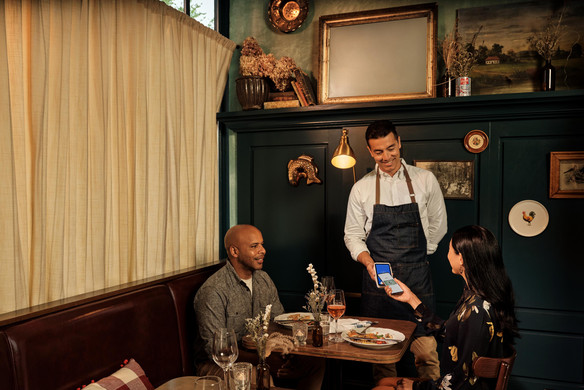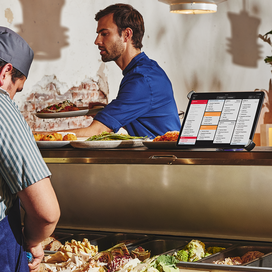Table of contents
You’ve likely heard it costs six to seven times more to acquire new customers than to retain an existing one. And further research shows improving customer retention can drive up profits. Just a 5% improvement in customer retention can increase profits by over 25%.
While nurturing customer relationships is a crucial part of any restaurant business, setting aside time to evaluate your approach can be challenging while daily responsibilities, from overseeing staff to reviewing sales reports, add up.
At the same time, the way restaurant businesses can interact with their customers is evolving, giving owners even more to consider. In a recent conversation with Kristen Barnett, founder of Hungry House, she explains, “No longer, especially with the rise of social media, is your popularity constricted to the people who can walk in your doors. You can have fans of what you’re doing across the country.”
The pressure is on to prioritize customer retention. But you may be wondering, “How do I define customer retention in the first place?” Or, “how can I improve my customers’ loyalty?” Let’s walk through strategies you can implement at various touchpoints with your guests, which can help inspire repeat visits that increase profits, starting with calculating your customer retention rate.
How do you define customer retention and how do you calculate it?
Customers expect great service in addition to factors such as your restaurant’s ambiance and food quality.
Kevin Hochman, CEO of Brinker International, Chili’s parent company, told The New York Times and Business Insider recently, “When you go out to eat you want to be waited on, and that hasn’t changed. Many people are returning to in-person dining after years of take-out,” he said, “and they are looking for a fast and fun, inviting atmosphere.”
You’ll want to ensure that every touchpoint is accounted for when both defining and looking to improve customer retention. But first, it’s essential to understand how to calculate your current retention rate, which represents the percentage of existing customers that continue to be customers after a certain period.
Find your restaurant’s customer retention rate with this formula:
[(# of customers at end of month/quarter – # of customers acquired during month/quarter) ÷ # of customers at start of month/quarter] x 100
4 restaurant customer retention strategies
Let’s look at a few opportunities to boost your restaurant’s customer loyalty across the several interactions they can have with your business.
1. Use an efficient POS that makes processes from ordering to paying easy.
Your point-of-sale system is the force behind your customers’ experience with your restaurant from beginning to end. How user-friendly it is for staff to operate sets the tone: One wrong order can prevent a customer from returning. Menu items should be easy to find and customizations should be simple to process to reduce the risk of your staff inputting mistakes.
The same goes for customers: If you’re a quick-service restaurant, you know guests prefer an efficient experience and want to get their orders in a timely manner. To give guests a sense of control over their wait time, consider installing self-service kiosks or terminals, which can help move lines along faster by allowing them to place their order on their own.
Imagine that after dining in your restaurant or picking up a to-go order, customers are held up waiting to pay due to busy staff or slow technology. This is another critical touchpoint that can impact their overall experience with your business and influence their decision to return, reiterating the importance of investing in an efficient point-of-sale system.
Research from Gartner shows that in order to avoid customer disloyalty, businesses must reduce the effort required from their customers. Square Restaurants POS, for example, accepts all forms of payment and provides tableside payment options, making the payment process seamless and easy for both your staff and customers.
2. Make it simple for customers to access your restaurant online.
Like Kristen put it, the experience your customers have with your restaurant stretches beyond your physical location. And with online ordering steadily increasing over the last few years, it’s become equally important for your business to have a strong online presence.
Today, online ordering is growing 300% faster than in-house dining and the majority of surveyed consumers (70%) said they would prefer to order directly from a restaurant than use a third-party service. You can appeal to this preference by setting up a website presence that easily allows guests to make reservations for their next visit, place orders online, or arrange for pickup.
If you don’t yet have a website, you can create an online ordering profile in just a few clicks. Or, if you want to take it a step further and build a custom website for your restaurant, Websites can provide a fully tailored experience.
3. Draw visitors back with ongoing communication.
After thinking about the experience your customers have while physically at your restaurant and online, you can begin to think about the ways you can continue to draw guests back to these spaces. Email and text campaigns are one way that you can help facilitate a relationship between your business and your customers and bring back lapsed customers by re-engaging them.
Email marketing alone has a significant ROI, bringing in $36 for every $1 spent. After Sabor Latin Street Grill began running email marketing campaigns with Square Marketing, their repeat diners started to significantly improve their sales. The restaurant’s email campaigns resulted in more than $40,000 in attributable sales during the first quarter of 2022, and their repeat diners spent 30% more on average than non-loyalty customers.
Social media is another way to communicate with customers and facilitate ongoing relationships. By monitoring dialogue in the comments section on your posts, you can respond proactively to customer feedback and show that you value your customers’ opinions and experiences — something they may consider when they’re deciding where they’ll have their next meal.
4. Give your guests personalized incentives to return.
It isn’t enough to simply message your guests, however. It’s important to thoughtfully consider the message you’re sending and ask yourself, “How can I make this valuable to them?” The majority (86%) of recently surveyed consumers, for instance, said they would be interested in joining a restaurant’s loyalty program if it provided discounts or coupons. Yet that same data revealed that only 36% of consumers actively participate in a loyalty program.
As a restaurant owner, you can respond to this demand by enlisting a loyalty and rewards platform like Square Loyalty, which allows you to provide personalized rewards and incentives based on visits, amount spent, or types of items purchased.
To make sure you’re sending the right message, you can work to understand your customer better through avenues such as customer surveys, data reports, or using customer relationship management (CRM) software. Square Customer Directory, for example, helps restaurant owners understand their customers better by providing valuable insights into their behavior, purchase history and payment preferences.
Benefits of restaurant customer retention
Prioritizing customer retention can lead to multiple benefits over time. You’ll likely see increased revenue, as repeat customers often spend more. And establishing regulars can help reduce seasonal fluctuations or downturns due to economic circumstances. For example, after Sabor Latin Street Grill used loyalty and email marketing opportunities, 24% of their sales came from loyalty program customers.
Boosting your restaurant customer retention and loyalty should be a top priority for any establishment seeking to increase its profits in a sustainable way. By leveraging effective strategies and modern tools, such as Square for Restaurants, restaurant owners can foster lasting relationships with their customers. The result? A thriving business with a loyal customer base that contributes — and cheers on — a restaurant’s long-term success.
![]()











